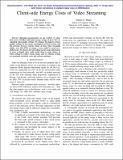Client-side energy costs of video streaming
Abstract
Through measurements on our testbed, we show how users of Netflix could make energy savings of up to 34% by adjusting video quality settings. We estimate the impacts of these quality settings on the energy consumption of client systems and the network. If users exercise choice in their video streaming habits, over 100 GWh of energy a year could be saved on a global scale. We discuss how providing energy usage information to users of digital video could enable them to make choices of video settings to reduce energy usage, and we estimate savings on associated electricity costs and carbon emissions.
Citation
Ejembi , O & Bhatti , S N 2016 , Client-side energy costs of video streaming . in J Chen & L T Yang (eds) , Proceedings - 2015 IEEE International Conference on Data Science and Data Intensive Systems : 11–13 December 2015 Sydney, Australia . , 7396511 , Institute of Electrical and Electronics Engineers Inc. , pp. 252-259 , 2015 IEEE International Conference on Data Science and Data Intensive Systems; 8th IEEE International Conference Cyber, Physical and Social Computing; 11th IEEE International Conference on Green Computing and Communications and 8th IEEE International Conference on Internet of Things, DSDIS/CPSCom/GreenCom/iThings 2015 , Sydney , Australia , 11/12/15 . https://doi.org/10.1109/DSDIS.2015.49 conference
Publication
Proceedings - 2015 IEEE International Conference on Data Science and Data Intensive Systems
Type
Conference item
Rights
Copyright © 2015 IEEE. This work is made available online in accordance with the publisher’s policies. This is the author created, accepted version manuscript following peer review and may differ slightly from the final published version. The final published version of this work is available at https://dx.doi.org/10.1109/DSDIS.2015.49
Items in the St Andrews Research Repository are protected by copyright, with all rights reserved, unless otherwise indicated.
Related items
Showing items related by title, author, creator and subject.
-
Virtual Worlds and the 3D Web – time for convergence?
Bakri, Hussein; Allison, Colin; Miller, Alan Henry David; Oliver, Iain Angus (Springer, 2016) - Conference itemMulti-User Virtual Worlds (MUVW) such as Open Wonderland and OpenSim have proved to be fruitful platforms for innovative educational practice, supporting exploratory learning and generating true engagement. However, when ... -
Studying programmer behaviour at scale : a case study using Amazon Mechanical Turk
Jacques, Jason T.; Kristensson, Per Ola (ACM, 2021-03-22) - Conference itemDeveloping and maintaining a correct and consistent model of how code will be executed is an ongoing challenge for software developers. However, validating the tools and techniques we develop to aid programmers can be a ... -
Investigating the accessibility of crowdwork tasks on Mechanical Turk
Uzor, Stephen; Jacques, Jason T.; Dudley, John J.; Kristensson, Per Ola (ACM, 2021-05-06) - Conference itemCrowdwork can enable invaluable opportunities for people with disabilities, not least the work fexibility and the ability to work from home, especially during the current Covid-19 pandemic. This paper investigates how ...

